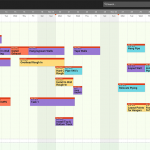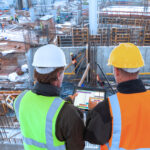Every country, industry and person is feeling the impact of COVID-19, and the construction industry is no exception. The ramifications from a flailing, “essential-only” economy will only be heightened with an estimated 34% drop in US GDP in Q2 2020. Current health and safety precautions are driving jobsites to engage in social distancing practices or even shut down altogether. And projects that were scheduled to start are seeing those start dates put off indefinitely. Post-virus, the construction community must brace for a surge in resource demands like materials and personnel.
One way to survive during these seemingly impossible times is to keep teams intact, replan and prepare, regardless of your construction project’s situation. It is also a great way to help alleviate the anxiety everyone is feeling. Here are some actionable steps every project can take right now to tackle specific issues COVID-19 is forcing us all to grapple with.
Project Scenario 1: Your Project Ordered a Social Distancing Requirement
Of all the situations, this is likely the most challenging. Why? Since you and your team are still allowed to be in the field, it might seem almost like business as usual, but keeping six feet of separation can be more difficult than you think. If you drill down into the proximity you and your team works within, you’ll quickly recognize that even a single foot seems like a mile. The best way to go about social distancing measures is to reduce on-site crew sizes overall. Consider the following to make keeping a safe space between team members manageable and productive:
- Assign Detailed Shift Work: Have half the crew work in the day, and the other half in the evening. Adding hours and changing up work schedules might seem overwhelming at first, but it’s better than downsizing the team, or falling behind on the project. Be sure to devise a way team members will understand how plan changes affect staffing across the entire project.
- Work in Parallel Locations: Get more work going on separate floors at the same time. Similar to assigning detailed shift work, this solution will automatically decrease the number of bodies in one spot, but keep the teams working safely and effectively.
- Conduct More Work Off-Site with Prefab: Offsite construction will undoubtedly help with on-site crew sizes, and prefabrication will force teams to think about what materials are absolutely necessary, and their sequence. Good demand signals — planning and doing things at the rate which people need them — are crucial for impactful prefab work to ensure seamless production and installation. This will boost trust and reliability in the workflow now and in the future.
- Explore a Variety of Scenarios: Advise the team to create a few situations so that a hitch in the first plan doesn’t derail the entire job. Thinking ahead with demand signals is one thing, but being prepared to switch the entire process on the fly will solidify minimal disruption, no matter what transpires.
Project Scenario 2: Your Project Ordered a Complete Stop to All Work
Boston was the first city to completely shut down all but emergency construction projects amidst the COVID-19 outbreak. But why did they stop? The unknown risks and lack of information caused immediate action for inaction. There were not enough conversations to derive alternative ideas and plans on how to keep working given the rapid spread of the virus. It’s okay to stop planning temporarily, but discontinuing all work is not the complete answer. How projects and teams adapt, and the action taken to do so, is the best way to jumpstart teams to regain momentum.
- Visualize Success: Athletes often ready themselves through visualization techniques; thinking through their situation to first understand it and ultimately prepare how to get through it and succeed. The exercise of mentally going through situations will put you and your team in a better position to take action rather than succumb to a complete standstill.
- Adapt: Think through the project shut down by talking the team through the environment you’re encountering and be prepared to start planning.
- Take Action: To begin planning, start by making assessments of the challenges and risks that you and the project face. A good way is to get people thinking and sharing together. Now is a perfect time to circle up with team members you may not always get the chance to work alongside. This will help open up the project to new possibilities from voices that may otherwise never be heard.
- Make People a Part of the Solution: Let your team know that the goal is to find ways to recover lost time. This needs to be a collective effort, so include design colleagues and trade partners along with other field team members. Making sure that the entire team is a part of the solution will increase accountability and provide innumerable ideas. Be sure to also leverage technologies that facilitate collaborative planning with remote team members.
- Set a Cadence with Tighter Handoffs to Recover Delays: Come up with the right pace for your project by identifying the smallest crew that does the most work and their pace. Have everyone staff for that pace while simultaneously removing any float to establish a better rhythm and flow. The idea is to collapse the schedule so teams can shave time off of the delayed project.
- Create a Reasonable Plan: The mission is to put together a plan to tighten up the process. Make a plan that’s not overly complex so the team can assess and adjust quickly. Be inclusive but mindful of how many people are invited as a part of replanning to keep things streamlined.
- Consider Alternative Plans: Try to anticipate any future roadblocks by looking several steps ahead. Ask additional people to review proposed plans to identify alternatives and challenges that you and the original planning team missed. Additionally, be sure to have a way to communicate and track plans electronically so that the process isn’t impacted by the lack of being on-site.
- Track the Plan and Learn from the Data: Almost as important as the plan execution, is tracking how it’s working. Be critical about the assumptions that were made and the success or areas for improvement. If changes are needed, be sure to alert the team and adjust as you learn. Be prepared to make modifications swiftly so the team can keep moving.
Project Scenario 3: Your Project Has an Indefinite Delayed Start
The project has been postponed indefinitely before you even had a chance to break ground. Don’t let the delay in starting construction impact crucial preparations that were underway. While the expectation is that the project will come back, the timeline is uncertain. During this state of uncertainty, there are still ways to proceed.
- Prepare for Tomorrow: Encourage design and precon teams take extra time to prepare. Conceptualize alternate situations and solutions knowing that projects will start to materialize again, and when they do a rush for resources like materials and personnel will create a shortage. Increased foresight and contingency plans will also help limit the anxiety felt by owners and banks who are funding the projects, successfully solidifying trust in your teams and organizations. Finally, take the time to utilize solutions you might not typically consider. Teams that engage in unconventional strategies will come out on top.
- Tap Into COVID-19 Experience: Projects in preconstruction and planning phases have a unique opportunity to learn and plan based on what other teams are encountering today. Most likely, your future team is preoccupied with an existing project; just because they’re on another site, doesn’t mean they can’t impact the plans for future jobs. Explore scenarios the incoming team is facing by having them share their current COVID-19 experience and knowledge. Figure out ways to replicate positive accounts, and how to create solutions for areas that need improvement.
This is a moment for the industry to level up in a variety of ways. Whether it’s putting work in place, learning a new skill, or taking a chance that ordinary circumstances don’t always favor, there are hundreds of ways to boost people, teams and jobs now that will help revive the industry when the economy bounces back.
For more ways to help project teams adapt during this unprecedented time, click here.










